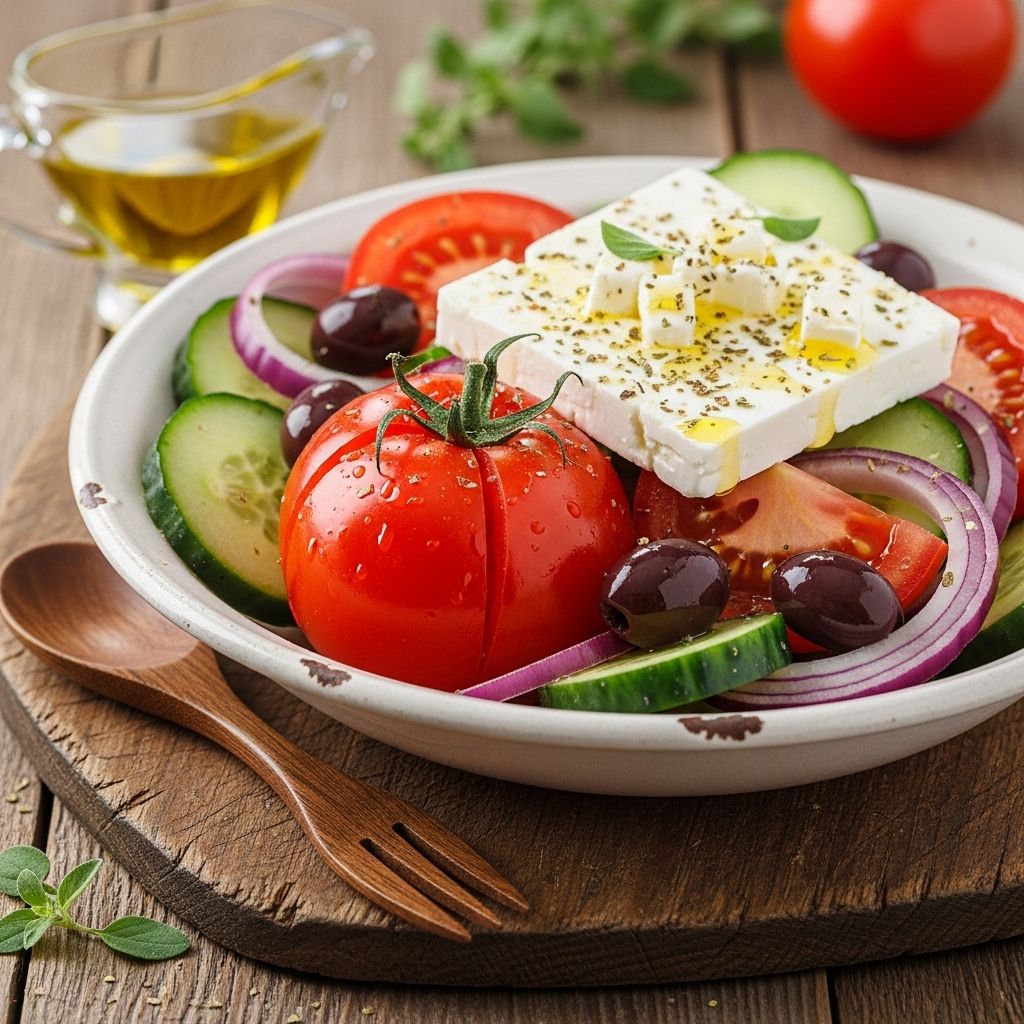The Ultimate Greek Salad Recipe: How To Make Horiatiki Like A Pro
Crisp vegetables and creamy feta unite in a dish that celebrates simplicity.

Image: HearthJunction Design Team
The Best Authentic Greek Salad Recipe: Master Horiatiki
There are few salads as vibrant and universally loved as the classic Greek salad, known as horiatiki in Greece. This timeless dish is celebrated for its crisp vegetables, creamy feta cheese, and briny Kalamata olives, all brought together by a punchy vinaigrette and a drizzle of the finest extra-virgin olive oil. Whether served as a refreshing side or a light lunch, the Greek salad is a showcase of the Mediterranean’s finest flavors and a testament to the beauty of keeping things simple.
What Makes Greek Salad (Horiatiki) Unique?
Unlike other chopped salads, a traditional Greek salad is all about letting the high-quality ingredients shine without heavy dressings or unnecessary components. It never contains lettuce and focuses on a few key vegetables, good olive oil, and a slab (not crumbles) of feta. Its roots are deeply embedded in Greek village cuisine, where seasonal produce and minimal fuss have reigned for generations.
Ingredients For the Perfect Greek Salad
Greek salad is wonderfully simple, but using the best possible ingredients makes all the difference. Here’s what you’ll need for authentic horiatiki:
- Cucumbers: Persian cucumbers are preferred for their mild flavor and easy prep—no peeling or seeding required. English cucumbers also work well. If using American slicers, peel to remove their bitter skin.
- Grape or Cherry Tomatoes: Choose the sweetest, firmest tomatoes you can find. Grape or cherry varieties are ideal due to their reliable texture and juiciness, but any beautifully ripe tomato will do.
- Red Onion: Thinly sliced red onion delivers sharpness and color. For a milder onion bite, briefly soak the slices in hot water, then rinse and dry before adding to the salad.
- Kalamata Olives: These quintessentially Greek olives provide briny depth. Pit them before adding. If unavailable, substitute with other good-quality black olives.
- Feta Cheese: Always opt for sheep’s milk feta, preferably in a block and packed in brine. Avoid pre-crumbled feta, which dries out and lacks flavor. Thick slices or large cubes are traditional—the chunky centerpiece of the salad.
- Extra-Virgin Olive Oil: The salad owes much of its flavor to the oil, so use one you truly enjoy. Greek olive oil is optimal for authenticity, but any high-quality, robust extra-virgin olive oil will suffice.
- Dried Oregano: Greek oregano is preferred, either dried or fresh and finely chopped. It provides an herby, slightly floral finish.
- Vinegar and Lemon Juice: A splash of red wine vinegar and lemon juice brings brightness and balances the flavors perfectly.
- Salt and Pepper: Kosher salt or sea salt highlights every fresh note; black pepper adds subtle spice.
Step-By-Step Directions
Achieving the perfect Greek salad comes down to technique and the order in which you combine ingredients:
- Prepare Your Vegetables:
– Slice cucumbers into half moons or thick rounds.
– Halve cherry or grape tomatoes, or large dice any bigger tomatoes.
– Thinly slice red onion. If desired, soak in hot water for 10-15 minutes to reduce pungency, then rinse under cold water and pat dry. - Assemble the Salad:
– In a large bowl, gently toss together cucumbers, tomatoes, red onion, and pitted olives. - Add the Feta:
– Cut feta into thick slices or large cubes and place on top of the vegetables. Leave the feta in big pieces for a more rustic, traditional presentation. - Make the Dressing:
– In a small bowl, whisk together red wine vinegar, lemon juice, dried oregano, salt, and pepper.
– Slowly stream in extra-virgin olive oil, whisking continuously, until the dressing becomes smooth and emulsified. - Combine and Serve:
– Drizzle the dressing over the salad and toss gently to combine—be careful not to break up the feta too much.
– Serve immediately, or let rest for a few minutes to allow the flavors to meld.
Tips for Classic Greek Salad Success
- Quality Over Quantity: The simplicity of horiatiki means every ingredient matters. Invest in top-tier produce, olive oil, and feta.
- Don’t Over-Mix: Gently combine the salad at the very last minute to keep the vegetables crisp and the feta intact.
- Serve at Room Temperature: Never refrigerate the salad for long periods; letting the ingredients come up to room temp ensures full flavor and aroma.
- Let the Tomatoes Sit: Tossing the tomatoes with a little salt and allowing them to rest pulls out their natural juices, making the salad even more flavorful.
- No Lettuce: Traditional Greek salad does not contain lettuce, celery, or carrots.
Greek Salad Variations & Ingredient Substitutions
While the authentic version is a paragon of Mediterranean minimalism, you can adapt your Greek salad to taste or in accordance with what’s available:
- Bell Pepper: Add sliced green bell pepper for crunch and earthiness, as is typical in many Greek households.
- Herbs: Fresh dill or parsley can add another fragrant, herbal note.
- Capers: For extra tang, toss in capers along with the olives.
- Cheese Alternatives: If you can’t find Greek feta, try Bulgarian or French sheep’s milk feta.
- Acid: Substitute white wine vinegar or a dash more lemon juice if red wine vinegar isn’t on hand.
- Olives: If Kalamata olives are unavailable, try other robust black olives, just be sure to pit them first.
Table: Core vs. Optional Greek Salad Ingredients
| Core Ingredient | Optional/Regional Variants |
|---|---|
| Tomatoes | Capers, green bell pepper |
| Cucumbers | Fresh herbs (dill, parsley) |
| Red onion | White onion |
| Feta cheese | Sheep/goat/Bulgarian feta |
| Kalamata olives | Other Greek or black olives |
| Extra-virgin olive oil | N/A |
| Dried oregano | Fresh oregano, dried thyme |
Serving Suggestions and Meal Pairings
Greek salad shines as both a standalone dish and as a complementary side. Pair it with:
- Grilled meats: Souvlaki (Greek skewers), lamb chops, or grilled chicken.
- Seafood: Pair with grilled fish or shrimp for a classic taverna experience.
- Bread: Mop up the juices with thick slices of crusty country bread or toasted pita wedges.
- Other salads: Serve alongside tabbouleh or a chickpea salad for a Mediterranean feast.
- Pasta: Toss with cooked pasta for a filling Greek pasta salad twist.
Frequently Asked Questions (FAQs)
Q: Is lettuce ever used in traditional Greek salad?
A: No. Authentic horiatiki never contains lettuce. It relies on the crispness of cucumbers and peppers for texture.
Q: Can I prepare Greek salad ahead of time?
A: Greek salad is best assembled just before serving, but you can slice the vegetables a few hours in advance and keep them refrigerated. Add the feta, olives, and dressing only at the very end to preserve freshness and texture.
Q: How long does Greek salad keep?
A: It can be stored in the refrigerator for up to 1 day, but the vegetables will soften and lose their crunch. For best results, eat immediately or within a few hours.
Q: What type of feta is best?
A: Seek Greek sheep’s milk feta packed in brine. It should be creamy and tangy, never dry or crumbly. Blocks are preferable to pre-crumbled cheese for authenticity and flavor.
Q: What makes the best Greek salad dressing?
A: The classic vinaigrette is made with red wine vinegar or lemon juice, whisked with olive oil, dried oregano, salt, and pepper. There are no creamy additives or sweeteners—just bright, clean Mediterranean flavors.
Nutrition & Health Benefits
Greek salad is not just delicious; it’s also nutrient-dense and aligns with heart-healthy Mediterranean eating:
- Vegetables: High in fiber, antioxidants, and vitamins A and C from cucumbers and tomatoes.
- Olive Oil: A rich source of monounsaturated fats, which support cardiovascular health.
- Feta Cheese: Delivers protein and calcium; choose sheep’s milk feta for a better nutrient profile and digestibility.
- Low Carb and Gluten-Free: Naturally fits into low-carbohydrate and gluten-free diets.
Pro Tips For Hosting a Greek Salad Bar
If entertaining, offer a Greek salad bar so guests can customize their bowls. Possible additions for variety:
- Marinated artichoke hearts
- Grilled chicken or shrimp
- Roasted red peppers
- Cooked orzo or farro for heartier salad bowls
- Fresh herbs for sprinkling
Set out small bowls of dressing so each person can drizzle their own; prep double the dressing to have extra on hand, as it goes quickly!
Conclusion: Why Homemade Greek Salad Is Unbeatable
Making your own Greek salad not only guarantees maximum freshness and flavor, but also allows you to tailor it to your preferences. When made properly—with bold, seasonal vegetables, authentic feta, and robust olive oil—it’s a dish impossible to tire of. Whether it’s lunch on a summer afternoon or a vibrant addition to a weeknight dinner, this Greek classic never fails to impress.
Greek Salad Recipe Card
- Servings: 4-6 people
- Prep Time: 15 minutes
- Total Time: 20 minutes
| Ingredient | Amount |
|---|---|
| Persian or English cucumber | 2 cups, sliced |
| Grape or cherry tomatoes | 2 cups, halved |
| Red onion | 1/2, thinly sliced |
| Kalamata olives | 1/2 cup, pitted |
| Feta cheese (block style) | 4-6 oz, thickly sliced |
| Red wine vinegar | 2 tbsp |
| Lemon juice | 1 tbsp |
| Extra-virgin olive oil | 1/4 cup |
| Dried oregano | 1 tsp |
| Salt & Black pepper | To taste |
Instructions: Combine vegetables and olives, top with thick-cut feta, whisk together dressing, pour over salad, toss gently. Serve immediately.
References
- https://www.delishknowledge.com/traditional-greek-salad-horiatiki-recipe/
- https://www.themediterraneandish.com/traditional-greek-salad-recipe/
- https://www.delish.com/cooking/recipe-ideas/a54226/best-greek-salad-recipe/
- https://www.delish.com/cooking/recipe-ideas/a65189623/greek-inspired-tortellini-salad-recipe/
- https://www.delish.com/cooking/recipe-ideas/a35843146/creamy-greek-salmon-salad-recipe/
Read full bio of Srija Burman












